Multiple Choice
Identify the
choice that best completes the statement or answers the question.
|
|
|
The Latino Presence
Grows
Spanish-speaking
Americans, or Latinos, have always been a large and diverse group. The country's Latino
population includes people from several different areas: Mexico, Puerto Rico, Cuba, the Dominican
Republic, other Caribbean islands, Central America, and South America. Because these groups all trace
their roots back to Spanish-speaking countries of Latin America, people often group them together.
However, each Latino group has its own history, its own pattern of settlement in the United States,
and its own set of economic, social, cultural, and political concerns . During the 1960s, the Latino
population in the United States grew from 3 million to more than 9 million.
During this time,
the number of Mexicans settling in the United States rose. Mexican Americans, who have always made up
the largest Latino group in the United States, once lived mostly in the Southwest and California.
Some were the descendants of the nearly 100,000 Mexicans who had lived in territories ceded by Mexico
to the United States after the war with Mexico in 1848. Others were the children and grandchildren of
the million or so Mexicans who settled in the United States in the decade following Mexico's
1910 revolution. Still others came as braceros, or temporary laborers, during the 1940s and 1950s.
And, of course, the largest number have recently come to the United States to escape poverty and
economic repression in Mexico. Since the 1960s millions have come to the United States, some legal
and some illegal, but they have all come to find a better way of life.
One of the great
success stories is the way that Mexican Americans have come to this country with very little
resources and managed to find their way into the American middle class. Within a generation many now
own their own businesses and contribute greatly to our culture and economy. In the United States they
have found successes that would have been impossible in their native Mexico.
|
|
|
1.
|
The Latino population in the
United States
a. | comes only from Mexico and
Cuba | c. | all speak
spanish | b. | is a diverse group that comes from many different countries in South and
Central America | d. | come only from
Mexico |
|
|
|
2.
|
The biggest migration of
Latino’s has come to the United States since the
a. | 1960s | c. | 1910 to 1920 | b. | 1940s to 1950s | d. | none of these |
|
|
|
3.
|
Why do most Latino’s come
to the United States?
a. | to escape political
persecution | d. | all of
these | b. | they do not like the climate in South and Central
America | e. | none of these | c. | to escape economic deprevation and take advantage of the
economic opportunities available in the Unites States |
|
|
|
4.
|
Which statement is
true?
a. | Latino’s remain stuck in
poverty in America, generation after generation | c. | Most Latino’s would have been better off had they remained in their
native countries. | b. | After a generation, many (if not most) Latino’s find their way into the
American middle class | d. | none of these statements are
true |
|
|
|
THE FARM WORKER MOVEMENT
Thousands of Mexican
Americans working on California's fruit and vegetable farms found themselves subjected to long
hours of backbreaking work for little pay and few benefits . Cesar Chavez believed that the only way to improve
conditions for farm workers was to unionize them, so that they could bargain as a group for improved
conditions and better treatment. In 1962, Chavez and Dolores Huerta established the
National Farm Workers Association.
Four years later, Chavez merged this group with a
Filipino agricultural union to form the United Farm Workers Organizing Committee (UFWOC).
Chavez and his fellow organizers insisted that California's large fruit and vegetable companies
accept their union as the bargaining agent for the farm workers. In 1965, when California's
grape growers refused to recognize the union, Chavez launched a nationwide boycott of the
companies' grapes . Chavez, like Martin Luther King, Jr., believed in nonviolence to achieve his
goals. His strategy was to win, through peaceful means, American public support for La Causa,
or the cause of social and economic justice for farm workers.
The union sent farm workers
across North America to convince supermarkets and shoppers not to buy California grapes. To call
further attention to the workers' plight, Chavez, in 1968, went on a three week fast in which he
lost 35 pounds. He ended his fast by taking communion with Senator Robert F. Kennedy.
The
efforts of the farm workers eventually paid off. In 1970, the grape growers finally signed contracts
with the UFWOC. The new contracts guaranteed union workers higher wages and other benefits long
denied them. "The boycott of grapes was the most near-perfect of nonviolent struggles,"
said Chavez afterward .
|
|
|
5.
|
Who started the National Farm
Workers Association?
a. | Cesar Chavez
| c. | both Chaves and
Huerta | b. | Dolores Huerta | d. | Robert
Kennedy |
|
|
|
6.
|
Which group joined with the
United Farm Workers Association to form the United Farm Workers Organizing
Committee (UFWOC)
a. | Japanese farm
workers | c. | Restaurant
Employees Association | b. | American Federation of Labor | d. | Filipino farm workers |
|
|
|
7.
|
In the 1960s which growers did
Cesar Chavez target for a boycott to build the union?
a. | lettuce
growers | c. | potato
growers | b. | grape growers | d. | meat processors |
|
|
|
8.
|
The boycott that Chavez led
was
a. | violent | c. | won by battling the police and
growers | b. | a bitter battle in the courts | d. | a non-violent protest that got
results |
|
|
|
9.
|
Which promenent American
politician gave his support to Cesar Chavez and the farm workers movement?
a. | Robert
Kennedy | c. | Bill
Clinton | b. | Barry Goldwater | d. | Gerald Ford |
|
|
|
CULTURAL
PRIDE
The activities of the
California farm workers helped to inspire other Latino "brown power" movements across the
country. In New York, Puerto Ricans began to demand that schools offer Spanish-speaking children
classes taught in their own language as well as programs on their culture . In 1968, Congress enacted
the Bilingual Education Act, which provided funds for schools to develop bilingual and cultural
heritage programs for non-English-speaking children
Young Mexican Americans started to call
themselves Chicanos or Chicanos-a shortening of "Mexicanos" that expressed pride in their
ethnic heritage . A Chicano community action group called the Brown Berets formed under the leadership of
David Sanchez. In 1968, the Brown Berets organized school walkouts in East Los Angeles high
schools . About 15,000 Chicano students walked out of class demanding smaller classes, more Chicano
teachers and administrators, and programs designed to reduce the high Latino dropout rate. Militant
Mexican-American students also won the establishment of Chicano studies programs at colleges and
universities
|
|
|
10.
|
Which statement is
true
a. | The Federal Government largely
ignored the demands and needs of the Latino community | c. | the federal government responded to the demands of the Latino Community but
the state of California ignored them | b. | The state governments ignored the demands and needs of the Latino
community | d. | the federal and state governments
responded to the demands and needs of the Latino
communities |
|
|
|
11.
|
In 1968 the Chicano drop-out
rate in LA city schools was
a. | low | c. | lower than the drop-out rate for their
parents | b. | high | d. | higher than the drop out rate for
their parents |
|
|
|
12.
|
Who started the Brown
berets
a. | Cesar
Chavez | c. | Jesse
Jackson | b. | David Sanchez | d. | Roberto Sanchez |
|
|
|
13.
|
Most of the demands of Latinos
centered around
a. | housing | c. | education | b. | jobs | d. | medicine |
|
|
|
POLITICAL
POWER
Latinos also began
organizing politically during the 1960s . Some worked within the two-party system to win support for
Latino issues and candidates. For example, the Mexican American Political Association (MAPA), which sponsored candidates,
registered and educated voters and lobbied for legislation that benefited the Latino community. In
1962, MAPA helped elect Los Angeles politician Edward Roybal to the House of Representatives. Roybal
was the second Mexican American to serve in Congress . Henry Gonzalez, elected to the House of
Representatives from Texas in 1961, was the first.
Others sought to create an independent
Latino political movement. That was the dream of Texan Jose Angel Gutierrez, who established
La Raza Unida (the United People Party) in 1970. In the 1970s, La Raza Unida ran Latino
candidates in five states and won positions on school boards and city councils, as well as several
races for mayor. Still other Latinos took on a more confrontational tone. Reies Tijerina, a
one-time evangelical preacher, argued that the United States had stolen some of the Latinos'
land. In 1963, Tijerina founded the Alianza Federal de Mercedes (Federal Alliance of Land Grants) to
help reclaim U.S. land taken from Mexican landholders in the 19th century.
|
|
|
14.
|
What did the Mexican American
Political Association (MAPA) do?,
a. | registered and educated
voters | d. | sponsored
candidates | b. | lobbied for legislation that benefited the Latino
community | e. | none of
these | c. | all of these |
|
|
|
15.
|
MAPA was a
a. | social
organization | c. | farm workers
association | b. | political organization | d. | legal aide organization |
|
|
|
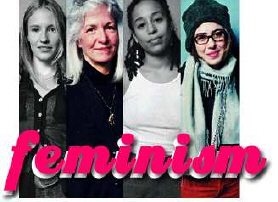 | A. A New Women's Movement
Arises
The theory behind
the women's movement of the 1960s was feminism, the belief that women should have economic,
political, and social equality with men. Feminist beliefs gained momentum during the mid-1800s and
led to woman suffrage, or women's right to vote, in 1920 . The women's movement declined
after this achievement. However, it reawakened during the 1960s, when many women began to recognize
their social and economic inequality. This realization helped spark a new, powerful feminist
movement. | | |
|
|
|
16.
|
The theory behind the
women's movement of the 1960s was feminism. What is feminism?
a. | women should have social equality
with men (social respect) | d. | all of these | b. | women should have economic equality with men (equal
pay) | e. | none of these | c. | women should have political equality with men (women in
politics) |
|
|
|
17.
|
What year did women get the
right to vote (suffrage)
|
|
|
B. WOMEN IN THE
WORKPLACE
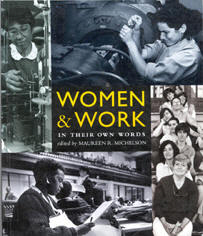 | By 1960, the number
of women joining the work force was on the rise. In 1950, only one out of three women had worked for
wages. By 1960, more than 40 percent of all women had jobs outside the home, and women made up a
third of the nation's work force. While their numbers were growing, however, working women
experienced widespread job and wage discrimination . Many occupations were considered
"men's work" and were closed to women. The jobs available to women-mostly clerical
work, domestic service, retail sales, social work, teaching, and nursing-paid poorly. The country
largely ignored the discrimination women faced in the workplace, until President Kennedy appointed
the Presidential Commission on the Status of Women in 1961. In 1963, the commission reported that
women were paid far less than men, even when doing the same jobs. Furthermore, women were seldom
promoted to management positions, regardless of their education, experience, and ability. The
discrimination that women faced in the workplace awakened many women to their unequal status in
society. | | |
|
|
|
18.
|
Who appointed a commission to
study the condition of women in the workplace in 1961?
a. | Lyndon
Johnson | c. | Richard
Nixon | b. | John F. Kennedy | d. | none of these |
|
|
|
19.
|
In 1961 about 40 percent of
women worked outside the home. Which job below might they have a chance of
getting?
a. | school
principal | d. | engineer | b. | business executive | e. | hotel manager | c. | school teacher |
|
|
|
20.
|
Although many jobs were closed
to women, they generally got the same pay if they did the same work?
|
|
|
C. SOCIAL ACTIVISM INSPIRES WOMEN
Other sources of
discontent for women stemmed from their involvement in the civil rights and antiwar movements.
Although both movements inspired many women to take action on behalf of their beliefs, the
discrimination they faced within the movements made them acutely aware of their inferior social
status .
In these organizations, men led most of the activities, while women were assigned
lesser roles . When women protested, the men usually brushed them aside. When activist Shulamith
Firestone tried to raise the issue of women's rights with antiwar activists, one man told her,
"Move on little girl; we have more important issues to talk about here than women's
liberation ." | 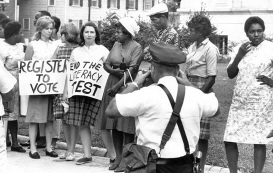 Despite their activism, women were not given
leadership roles in the civil rights movement Despite their activism, women were not given
leadership roles in the civil rights movement
| | |
|
|
|
21.
|
Which statement is
true?
a. | In the civil rights movement, women
found the equality they were looking for | c. | Disrespect for women came only from the “conservative” parts of
American society | b. | Women who joined the anti-war movement were treated with respect and
equality | d. | Women found little equality in the
civil rights or anti-war movements of the 60s |
|
|
|
22.
|
Women formed small groups to
discuss their problems and the discrimination they experienced in society. What were these groups
called?
a. | reality therapy
discussions | c. | transcendental
meditation experiences | b. | consciousness-raising" sessions | d. | global awareness discussions |
|
|
|
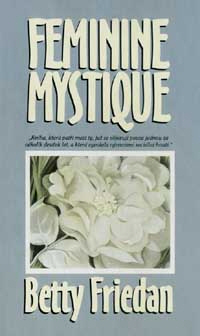 |
D. THE WOMEN'S MOVEMENT
EMERGES
In 1963,
Betty Friedan published The Feminine Mystique, which captured the very discontent that many
women were feeling. The book quickly became a bestseller. From across the country, women wrote to
Friedan to thank her for exposing "the problem that has no name" and to tell her their own
painful stories. "Thank God someone had the insight and courage to write it," an Iowa woman
wrote .
Friedan's book helped galvanize a number of women throughout the nation . By the
late 1960s, women across the country were coming together to work for change . "This is not a
movement one `joins,"' observed Robin Morgan. "The Women's Liberation movement
exists where three or four friends or neighbors decide to meet regularly . . . on the welfare lines,
in the supermarket, the factory, the convent, the farm, the maternity ward. .
. | | |
|
|
|
23.
|
What effect did Betty Friedan’s book, “The Feminine Mystique,” have on
women?
a. | made them aware of their
condition | d. | none of
these | b. | galvanized (motivated) them to take action | e. | all of these | c. | got them talking to each other about their
problems |
|
|
|
E. The Womens Movement Experiences
Gains
As the women's
movement grew, it achieved remarkable political and social gains for women.
THE CREATION
OF NOW
The Civil Rights Act of 1964, prohibited discrimination based on race, religion,
and national origin-had. There was also a provision outlawing discrimination based on gender. One
result of the gender provision was that the Equal Employment Opportunity Commission (EEOC)-an
organization set up to investigate discrimination claims by African Americans and women's job
complaints.
By 1966, however, some women voiced dissatisfaction with the EEOC. They argued
that the commission showed an overall lack of attention toward the flood of women's grievances .
That year, several women, including Betty Friedan, created the National Organization for Women (NOW)
to pursue more actively women's goals .
NOW moved into action quickly. Its members
pushed for the creation of more child-care facilities and for improved educational opportunities for
women. NOW also pressured the EEOC to enforce more vigorously the ban on gender discrimination in
hiring . NOW's efforts prompted the EEOC to declare sex-segregated job ads illegal and issue
guidelines to employers, stating that they could no longer refuse to hire women for traditionally
male jobs . |
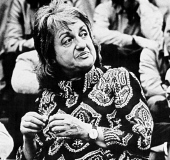 Betty Friedan Betty Friedan
Helped to
found NOW
| | |
|
|
|
24.
|
Which type of discrimination
did the Civil Rights Act of 1964 fail to address?,
a. | discrimination based on
race | d. | discrimination based on national
origin | b. | discrimination based on gender | e. | the act addressed all of these forms of
discrimination | c. | discrimination based on religion |
|
|
|
25.
|
The Civil Rights Act of 1964
set up the Equal Employment Opportunity Commission (EEOC). The purpose of
this commission was to investigate discrimination against African Americans and women
in
a. | housing | c. | hiring | b. | borrowing money | d. | education |
|
|
|
26.
|
What motivated Betty Friedan
and others to form the National Organization for Women (NOW)?
a. | the EEOC was not paying enough
attention to women’s complaints | c. | the government would not allow women to take combat roles in the
military | b. | the Civil Rights Bill of 64 did not say anything about
women | d. | women were being denied proper medical attention
|
|
|
|
27.
|
Which goal did NOW
fail to address
a. | improved educational
opportunities | d. | more child-care
facilities | b. | ban on gender discrimination in hiring | e. | NOW addressed all of these issues | c. | sex-segregated job
ads |
|
|
|
F. A DIVERSE MOVEMENT
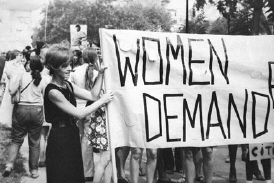
In its first three
years, NOW's ranks swelled from 300 to 175,000 members. Outside of NOW, a number of other
women's groups sprang up around the country. In 1968 a militant group known as the New York
Radical Women staged a well-publicized demonstration at the annual Miss America Pageant. To protest
the concept of judging women's beauty, the women threw bras, girdles, wigs, and other
"women's garbage" into a "Freedom Trash Can." They then crowned a sheep as
"Miss America ." In 1971, journalist Gloria Steinem helped found the National Women's
Political Caucus, a group that encouraged women to seek political office. |
The radicals
and moderates within the movement often quarreled over strategy. However, these diverse factions put
aside their differences in August 1970 to join in the largest women's rights demonstration ever.
To commemorate the 50th anniversary of woman suffrage, tens of thousands of women gathered from
around the country and marched through New York City to promote women's equality.
By the
early 1970s, the women's movement had scored several victories on the political and social
fronts . In 1972, Congress passed a ban on gender discrimination in "any education program or
activities receiving federal financial assistance," as part of the Higher Education Act. (called
Title 9) As a result, several all-male colleges opened their doors to women. That same year, Congress
expanded the enforcement powers of the EEOC and gave working parents a tax break for child-care
expenses.
| | |
|
|
|
28.
|
Which statement is
true?
a. | NOW sought to have the wearing of
bras in the workplace banned | d. | Women adopted the sheep as a symbol for the womens
movement | b. | In the early 70s NOW, as well as other women’s, groups grew in numbers
to become the “Womens Movement.” | e. | all of these are true | c. | Women were happy about the Miss America pageant because it
recognized the talent and beauty of American women |
|
|
|
29.
|
According to the Higher Education Act.of 1972
a. | private schools could not ban girls
from auto shop classes | d. | none of these are
true | b. | public and private school programs could not discriminate against women if
they took federal funds | e. | boys in public schools were forced
to take classes in cooking and sewing | c. | whether or not a school or program received federal funds did not effect
discrimination practices |
|
|
|
30.
|
Gloria Steinem was mainly
interested in helping women
a. | get better jobs in the corporate
world | c. | to run for political
office | b. | get administrative jobs in education | d. | to legalize abortion |
|
|
|
G. ROE V. WADE
One of the more
controversial issues that NOW and other feminist groups supported was a woman's right to have an
abortion. In 1973, the Supreme Court ruled in the case Roe v. Wade that women had the right to choose
an abortion during the first three months of pregnancy. In an editorial on the decision, the New York
Times expressed hope that the ruling might "bring to an end the emotional and divisive public
argument." However, this did not happen . Americans today remain divided over the abortion issue
.
|
|
|
31.
|
What did the Supreme Court rule
in 1973 in the Roe v. Wade decision
a. | that women had a right to an
abortion at any time (abortion on demand) | c. | that women had a right to an abortion in the first 3 months of
pregnancy | b. | that teenagers did not have to tell their parents to get an
abortion | d. | that women did not have a right to
an abortion unless their life was in danger because of the
pregnancy |
|
|
|
32.
|
Roe v. Wade was a popular
decision in 73 and almost all Americans now support the decision.
|
|
|
H. THE EQUAL RIGHTS AMENDMENT
| In what seemed
at first to be another triumph for the women's movement, Congress passed the Equal Rights
Amendment (ERA) in 1972. This was a constitutional amendment that needed ratification by 38
states-three-quarters of the 50 states-to become part of the Constitution. The ERA, which had first
been introduced to Congress in 1923, would have guaranteed that
"Equality of rights under the law shall not be
denied or abridged by the United States or by any state on account of sex ."
The ERA
supporters argued that the amendment was needed to make sure that men and women could not be treated
differently under the law solely because of their gender. It was, they said, a matter of "simple
justice." Opponents argued that the amendment was poorly written and failed to define what
“rights” meant.
In spite of several extensions in time, the Equal Rights Amendment
failed to get the required 38 states for ratification. It never did become part of the
constitution. | | |
|
|
|
33.
|
How many states are needed to
ratify a change to the constitution?
a. | 50 | c. | two thirds | b. | one half | d. | three quarters |
|
|
|
34.
|
The Equal Rights Amendment was
mainly concerned with the rights of
a. | African
Americans | c. | Women | b. | Latino’s | d. | Children |
|
|
|
35.
|
When was the Equal Rights
Amendment to the constitution first introduced in congress?
|
|
|
36.
|
What eventually happened to the
ERA?
a. | it passed and is now Amendment 27 to
the constitution | c. | it failed to get
the approval of the required number of states and it died | b. | it is still in the process of being voted
on | d. | it passed and is now Amendment 26 to the
constitution |
|
|
|
I. CONSERVATIVES AND THE WOMEN'S MOVEMENT
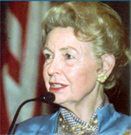
Phyllis Schlafly | The ERA amendment sparked fierce
opposition from conservative religious groups, political organizations, and many women who opposed
the feminist movement. These groups raised fears that the ERA would lead to "a parade of
horribles," such as the drafting of women, the end of laws protecting homemakers, and same-sex
marriages . One prominent ERA opponent was Phyllis Schlafly. In 1972, Schlafly founded and became
national chairman of the Stop-ERA campaign. Schlafly characterized the ERA as the work of radical
feminists who "hate men, marriage, and children" and whose oppression existed "only in
their distorted minds."
The Stop-ERA campaign also attracted support from many women who
feared its impact on families . Many worried that the amendment would end a husband's
responsibility to provide support to his wife and children. They feared that broken families would
produce broken children. | | |
|
|
|
37.
|
Who were the main opponents of
the ERA?
a. | Conservatives | c. | Socialists | b. | Liberals | d. | Communists |
|
|
|
38.
|
Social Conservatives warned
that passage of the ERA would lead to
a. | same-sex
marriages | d. | drafting of women
in the military | b. | all of these | e. | none of these | c. | end of laws protecting homemakers |
|
|
|
39.
|
Phyllis Schlafly was
a. | a Social Conservative opposed to the
ERA | c. | a founder and member of NOW who
supported the ERA | b. | a feminist who supported the ERA | d. | a Socialist who opposed the ERA |
|
|
|
40.
|
Many moderate women opposed the
ERA because
a. | it did not go far
enough | c. | they were afraid of their
husbands | b. | they feared the impact of the ERA on family
life | d. | it might endanger a womens right to
vote |
|
|
|
J. Pro Family Movement

Pro
family
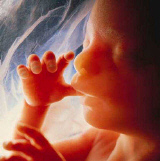
anti-abortion
movement | During the 1970s, conservatives built on their opposition
to the ERA and the Roe v. Wade abortion decision by gaining support for what they called a new
"pro-family" movement. Jo Anne Gasper, editor of a newsletter
entitled The Right Woman, described this movement as a "broad-based coalition of social
conservatives who recognize the value of the person, the importance of the family, the rights and
responsibilities of parents, and the importance of restricting government so that there can be
personal freedom."
This coalition of social conservatives-which focused on social,
cultural, and moral issues-came to be known as the New Right.* The New Right and the
women's movement debated family-centered issues such as federally funded day care, which the New
Right opposed. Throughout the 1970s, the New Right built grassroots support for social conservatism ;
in fact, it would play a key role in the election of Ronald Reagan to the presidency in
1980.
* (In politics, people on the right are called conservatives while people on the left
are called liberals) | | |
|
|
|
41.
|
The social conservatives in the
pro-family movement recognized
a. | the rights and responsibilities of
parents | d. | all of
these | b. | the importance of the family | e. | none of these - social conservatives only care about
themselves | c. | the importance of restricting government so that there can be personal
freedom |
|
|
|
42.
|
What was the New
Right?
a. | a coalition (group) of conservatives
who cared about family issues | c. | a coalition of women who worked to pass the
ERA | b. | a group of feminists who tried to protect a womans right to an
abortion | d. | none of
these |
|
|
|
43.
|
Ronald Reagan supported
a. | New Right
Conservatives | c. | Social
Liberals | b. | New Left Liberals | d. | Socialists |
|
|
|
K. The Movement's
Legacy
The New Right
and the women's movement clashed most dramatically over ERA, By 1977, the ERA had won approval
from 35 of the 38 states needed to ratify the amendment. At that point, however, the amendment
stalled, as opposition to the ERA gained strength . By the end of 1982 (the deadline for
ratification), no other states had approved the amendment. The ERA went down in defeat . Despite ERAS
defeat, the women's movement succeeded in opening up new opportunities for American women and
dramatically altering their roles in society.
For instance, the movement left its mark on
education. In 1970, 8 percent of all medical school graduates and 5 percent of all law school
graduates were women. By 1992, those proportions had risen to 36 and 43 percent,
respectively.
The women's movement also changed the way women looked at work and careers.
In the 1950s, most women who took jobs had done so mainly to "help out." By the 1970s, many
women were preparing themselves for lifetime careers. Still, many women ran into a "glass
ceiling"- an invisible, but very real, resistance to promoting women into top positions. The
women's movement brought women into the political arena in growing numbers. Women held only 3.5
percent of elected state offices in 1969. By 1996, 25 percent of elected state officeholders were
women. The number of women in Congress also has increased-from 19 in 1975 to 60 in 1997. Most of all,
the women's movement helped countless women open their lives to new possibilities. "We have
lived the second American revolution," wrote Betty Friedan in 1976
In most nations of
the world, Africa, Asia, South America and the Middle East, women are little more than slaves and
live as they have for thousands of years. In America, thanks to women like Betty Friedan and
the womans movement, women are free, strong and important members of our society who help to
make our nation a better place to live for everyone, men and women. |
 Empowered Women Empowered Women
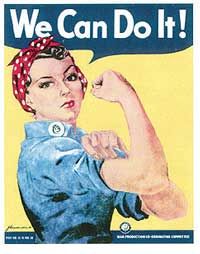
Rosie the Riviter WWII | | |
|
|
|
44.
|
The women’s movement
a. | brought many new women into
politics | d. | helped women to
achieve a new sense of dignity, self worth and independence | b. | helped women to develop careers in traditional male
dominated professions | e. | all of
these | c. | opened male dominated schools to
women |
|
|
|
45.
|
Martin Luther King is to the
civil rights movement as Betty Friedan is to
a. | NOW National Organization of
Women | c. | feminist
movement | b. | ERA Equal Rights Amendment | d. | social conservative movement |
|
|
|
The
Counterculture
In the late
1960s, the historian Theodore Roszak described the rise of these idealistic youths as the
"counterculture ." It was a culture, he said, so different from the mainstream "that
it scarcely looks to many as a culture at all, but takes on the alarming appearance of a barbarian
intrusion ." The so-called alarming barbarians were mostly white middle-class college youths .
And while they indeed did create a culture different from the mainstream, their lack of organization
and direction-as well as the devastating effects of drug use-led to the counterculture's
eventual collapse
|
|
|
46.
|
The counter culture was
composed mostly of
a. | inner city black
youths | c. | gays and
lesbians | b. | middle class white youths | d. | upper class white and southern black
youths |
|
|
|
47.
|
What led to the eventual
collapse of the counter-culture (hippie) movement?
a. | police
infiltration | c. | lack of
numbers | b. | attacks by the gray panthers | d. | lack of organization and drugs |
|
|
|
| "TUNE IN, TURN ON, DROP OUT"
Members of the counterculture, known as hippies, shared
some of the beliefs of the New Left movement, namely that American society-and its materialism,
technology, and war-had grown hollow. A number of hippies even participated in various New Left
demonstrations, including its many protests against the Vietnam War. However, a majority of hippies
chose to protest against society by leaving it.
Influenced heavily by the nonconformist beat movement of the 1950s, hippies
eagerly embraced the credo voiced by Harvard psychology professor and counterculture philosopher
Timothy Leary: "Tune in, turn on, drop out." Throughout the mid- and late 1960s, tens of
thousands of idealistic young Americans left behind their established worlds of school, work, or home
to live with one another in the streets, parks, and group homes . Their goal was to create, in the
midst of what they viewed as a cold and cruel nation, an idyllic setting of peace, love, and
harmony. | | |
|
|
|
48.
|
Having a good job, owning your
own home and car, and living the good life is sometimes called, “materialism.” How did
the hippies (counter culture) feel about materialism?
a. | they were in favor of
it | c. | they did not care about it one way
or the other | b. | they were against it | d. | they favored it as long as they did not have to get a
job |
|
|
|
49.
|
What does, “tune in, turn
on and drop out,” mean?
a. | tune in to the radio, turn on your
CD player and drop out of society | c. | tune in to president Johnson, turn on the radio and drop out of
college | b. | tune in to the government, turn on your mp3 player and drop out of the
military | d. | tune in to the message of the
counter culture, turn on to drugs and drop out of
society |
|
|
|
50.
|
The counter-culture hippie
generation was
a. | idealistic about the way society
should be | d. | all of
these | b. | cynical about American materialism | e. | none of these | c. | anti war |
|
|
|
HIPPIE
CULTURE
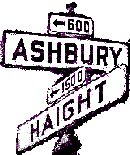 The creation of this peace and love, which some called
an Age of Aquarius, usually involved three things : rock 'n' roll music, colorful clothing
and appearance, and the liberal use of drugs-both marijuana and a new hallucinogenic, or
mind-altering, compound called LSD, or acid. Timothy Leary, an early experimenter with LSD, promoted
the drug as a "liberating" and "mind-expanding" aid in the search for greater
self-awareness and inner peace. The creation of this peace and love, which some called
an Age of Aquarius, usually involved three things : rock 'n' roll music, colorful clothing
and appearance, and the liberal use of drugs-both marijuana and a new hallucinogenic, or
mind-altering, compound called LSD, or acid. Timothy Leary, an early experimenter with LSD, promoted
the drug as a "liberating" and "mind-expanding" aid in the search for greater
self-awareness and inner peace.
Aside from illegal drug use, hippies showed their rejection of
the establishment by wearing what were then considered outrageous clothes . Many young men and women
wore ragged jeans and tie-dyed T-shirts, as well as surplus plus military garments. In addition, many
hippies enhanced their outfits with beads and Native American ornaments. Men grew long hair and
beards. To many hippies, long hair symbolized the freedom to "do your own thing." To the
older generation, long hair symbolized a lack of respect for social conventions . Signs went up
across the country saying "Make America Beautiful-give a hippie a haircut
."
|
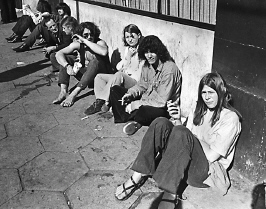
Hippies also turned their backs on conventional home life. Many chose to
live together in communes-group living arrangements in which the members renounced private property
to live together in cooperation and harmony. For some, this meant establishing rural communes; for
others, it meant crowding together in urban "crash pads." Scores of hippies flocked to
Chicago's Old Town, Atlanta's Fourteenth Street, New York City's Greenwich Village,
and especially San Francisco's Haight-Ashbury district.
By the mid-sixties,
Haight- Ashbury had become the hippie capital, mainly because of the availability of hallucinogenic
drugs, which California did not outlaw until late 1966 . | | |
|
|
|
51.
|
Why did the hippies choose the
Haight Ashbury district of San Francisco as their capital in the 1960s?
a. | California did not outlaw
hallucinogenic drugs until the late 60s | c. | California was against the Vietnam
War | b. | The business community of San Francisco encouraged the
hippies | d. | Haight Ashbury was not the hippie
capital |
|
|
|
52.
|
Which statement is
true
a. | The hippies seemed to reject all
societal customs, even conventional family life | c. | Except for the clothing and haircuts, hippies generally accepted most social
conventions | b. | The hippies rejected society and it’s conventions but lived in
traditional marriage situations | d. | There were very few black hippies because the counter-culture was
racist |
|
|
|
Many disillusioned youths also sought
fulfillment through new and different religious experiences . Rejecting traditional forms of worship,
scores of young men and women turned to the teachings of such Eastern religions as Zen Buddhism.
According to the Zen philosophy, people attain enlightenment through meditation, self-contemplation,
and intuition, rather than through the reading of scriptures .
Influenced by the preaching of spiritual gurus, such
as Maharishi Mahesh Yogi of India, thousands of Americans began taking informal courses in mystical
meditation and forming groups to practice what they learned. In 1968, the news media declared that
more than 10,000 of the nation's youths had become "transcendental meditators." Later
that year, Life magazine proclaimed 1968 to be the "Year of the
Guru." | 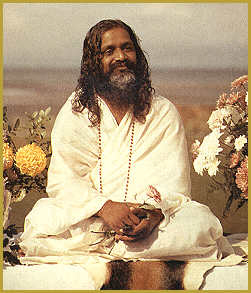
Maharishi Mahesh
Yogi | | |
|
|
|
53.
|
What did the Year of the Guru mean?
a. | it was a time when hippies accepted
traditional religion | c. | it was a year when
Guru Catholics became an important religion | b. | it was a time when hippies rejected conventional religion
for unconventional forms of worship | d. | none of these refer to the year of the
Guru |
|
|
|
DECLINE OF THE MOVEMENT
After only a few years, the counterculture's peace and harmony gave way
to violence and disillusionment . The urban communes eventually turned seedy and dangerous, as they
became havens for muggers, drug dealers, and runaways . "It got very ugly very fast," Alex
Forman recalled. "There were ripoffs, violence . . . people living on the street with no place
to stay."
In 1969, two episodes of counterculture violence shocked America. In August,
commune leader Charles Manson and his "family" murdered actress Sharon Tate. Four months
later at the Altamont Raceway in California, the Hell's Angels motorcycle gang beat a man to
death in front of the stage where the Rolling Stones, a British rock band, were playing .
By
1970, the widespread use of drugs had further eroded the counterculture movement . Many young people
fell victim to the drugs they used, experiencing overdoses, drug dependence, and mental and physical
breakdowns. The popular rock singer Janis Joplin and the legendary guitarist Jimi Hendrix both died
of drug overdoses in 1970.
| 
More than anything else, however, the hippies eventually discovered that they
could not sustain themselves outside of mainstream America. Even though they tried to reject
conventional society, many hippies found themselves ultimately dependent on it. Numerous
hippies ended up panhandling on street corners and lined up at government offices, collecting welfare
and food stamps to help them survive the trials of natural living. "We were together at the
level of peace and freedom and love," said one disillusioned hippie. "We fell apart over
who would cook and wash the dishes and pay the bills." | | |
|
|
|
54.
|
Which statement is
true
a. | Hippies found that they needed the
culture that they rejected in order to survive | d. | all of these statements are true | b. | Drugs were a major cause of the decline of the hippie
counter culture | e. | none of these statements are
true | c. | In some cases the counter culture led to extreme violence and
brutality |
|
|
|
A Changing Culture
Although the counterculture movement
was short-lived, some aspects of it namely, its fashion, fine arts, and social attitudes-left a more
lasting imprint on mainstream America and on the rest of the world
ART AND FASHION
The counterculture's rebellious style left its mark on the worlds of art and
fashion . The 1960s saw the rise of popular, or pop, art. Pop artists, led by Andy Warhol, attempted
to bring art into the mainstream. Warhol became famous for his bright silk-screen portraits of soup
cans, Marilyn Monroe, and other icons of mass culture .
To a larger extent, the
counterculture's legacy lived on in the way many Americans dressed and groomed themselves .
While most Americans did not adopt the out outlandish look of hippies, many came out of the sixties
wearing longer hair, more colorful clothing, and blue jeans, which became a staple in nearly every
American's wardrobe. | 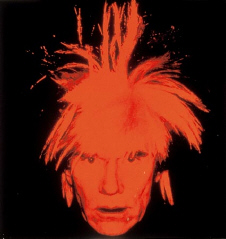
Andy Warhol Self Portrait
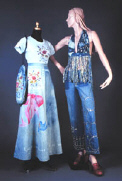 Hippie
Fashion Hippie
Fashion | | |
|
|
|
55.
|
Some forms of counter culture
art and fashion have come to be accepted today
|
|
|
ROCK MUSIC
Perhaps the most lasting legacy of the counterculture
movement was its music. During the 1960s, the hippie movement embraced rock 'n' roll-the
offshoot of African-American rhythm and blues music that had captivated so many teenagers during the
1950s-as its loud and biting anthem of protest . However, as the years went on, rock music melded
into the mainstream and is today one of the more recognizable characteristics of American
youth.
The band that, perhaps more than any other, helped propel rock music into mainstream
America was the Beatles . The British band, made up of four youths from working-class Liverpool,
England, arrived in America in 1964 and immediately took the country by storm . By the time the
Beatles broke up in 1971, the four "lads" from Liverpool had inspired a countless number of
other bands and had won over millions of Americans to rock 'n' roll .
|
|
|
56.
|
The Beatles were the best known
rock music group of the 60s
|
|
|
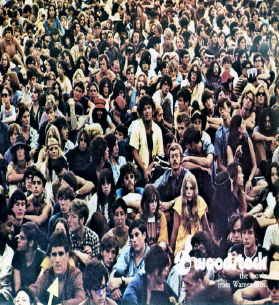 | WOODSTOCK
One dramatic example of rock 'n' roll's exploding popularity
occurred in August 1969 on a farm in upstate New York. There, about 120,000 young people were
expected to gather for a free music festival called "Woodstock Music and Art Fair, an Aquarian
Exposition." More than 400,000 showed up . For three days, the most popular bands and musicians
of the time performed, including Jimi Hendrix, Janis Joplin, Joe Cocker, Joan Baez, the Grateful
Dead, and Jefferson Airplane . Despite the huge crowd, the event, which became known simply as
Woodstock, was remarkably peaceful and well-organized. However, not everyone remembered it as three
days of bliss. Tom Mathews, a writer who attended the Woodstock festival, later recalled his
experience there. | | |
|
|
|
57.
|
What was
Woodstock
a. | a hippie
commune | c. | a rock
concert | b. | an anti-Vietnam war protest | d. | a pro Vietnam war rally |
|
|
|
CHANGING ATTITUDES
As the counterculture movement faded, its casual, "do
your own thing" philosophy left an imprint on Americans' social attitudes. In particular,
American attitudes toward sexual behavior became more permissive, leading to what became known as the
sexual revolution . During the 1960s and 1970s, mass culture-which included books, magazines, and
movies-began to more openly address subjects that had once been prohibited, particularly sexual
behavior and explicit violence.
While some hailed the increasing permissiveness as a
liberating force, others attacked it as a sign of moral decay. Millions of Americans opposed the
country's increasingly permissive social behavior. While the counterculture movement eventually
helped prompt many Americans to adopt more liberal attitudes about dress and appearance, music, and
social behavior, the movement's immediate impact on the country produced the opposite
effect.
In 1968, conservative commentator William F. Buckley announced that his magazine, the
National Review, was starting a newsletter to expose rebellious students, antiwar radicals, and
Communist forces that he claimed were behind the New Left. FBI Director J. Edgar Hoover issued a
warning to the nation's police officers that "revolutionary terrorism" was a threat to
law and order on campuses and in cities . Other conservative critics warned the public that campus
rebels posed a danger to traditional values and threatened to plunge American society into anarchy
and lawlessness.
|
|
|
58.
|
Which statement is
true
a. | The sexual revolution was inspired
by Soviet Communism as a way to destroy American society | c. | Liberals saw the sexual revolution as a threat to American
culture | b. | The sexual revolution caused American young people to adopt a more traditional
attitude toward sex | d. | Conservatives saw the sexual
revolution as a threat to American culture |
|
|
|
CONSERVATIVES ATTACK THE
COUNTERCULTURE
Conservatives also attacked the counterculture for what they saw as its decadent values
: glorification of drug use, indulgent sexual behavior, and indifference toward work. In the view of
psychiatrist Bruno Bettelheim, student rebels and members of the counterculture had been pampered in
childhood; as young adults, they did not have the ability for delayed gratification
.
According to some conservative commentators, the counterculture had abandoned rational
thought in favor of the senses and restraint for uninhibited self-expression. The counterculture,
they believed, was undermining the capacity of young Americans to debate issues rationally.
The angry response of mainstream Americans to the disorders caused a profound change in the
political landscape of the United States . By the end of the 1960s, conservatives were presenting
their own solutions on such issues as lawlessness and crime, the size of the federal government, and
welfare . This growing conservative movement would propel Richard M. Nixon into the White House-and
set the nation on a more conservative course.
|
|
|
59.
|
As illustrated by the
presidential elections, by the late 60s most Americans _____ conservative attacks on the counter
culture
a. | neither | c. | agreed with | b. | both | d. | disagreed with |
|
|
|
60.
|
It can be said that the
counter-culture helped the conservatives to take control of the government because it gave them
issues that most Americans agreed with. Because the hippies and the counter-culture were associated
with liberal politicians and the democrat party, a majority of Americans gave their support to
conservative Republicans
|
|
|
61.
|
Given the choice, most parents
in the 60s and 70s would rather have their children be
a. | young
hippies | c. | bikers | b. | young conservatives | d. | successful drug dealers |
|
|
|
Native Americans Struggle
for Equality
Many people
view Native Americans, like Latinos, as one group, despite the hundreds of distinct Native American
tribes and nations in the United States. During the 1960s, many Native Americans joined together to
demand improvements in their conditions.
|
|
|
62.
|
What do Latino’s and
Native Americans have in common?
a. | they are often viewed as a single
group, rather than diverse groups | c. | they both speak mostly Spanish | b. | they are ethnic groups with a single
identity | d. | neither group are allowed to own
land in the United States |
|
|
|
63.
|
When did Native Americans begin
to demand improvements in their condition?
a. | 1960s | c. | 1980s | b. | 1990s | d. | 2001 |
|
|
|
NATIVE AMERICANS SEEK GREATER AUTONOMY
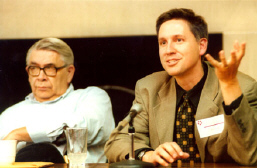
Vine
Deloria & Vine Deloria Jr
In an attempt to deal with these problems, the
Eisenhower administration in 1953 enacted a termination policy designed to relocate Native Americans
from isolated reservations into mainstream urban American life. The plan failed miserably. Most of
the Native Americans who moved to the cities remained desperately poor.
| In addition, many Native Americans refused to assimilate, or blend, into
mainstream society. Native American nationalist Vine Deloria, Jr., expressed his opinion that young
Native Americans viewed mainstream America as nothing more than "ice cream bars and heart
trouble and neurosis and deodorants and getting up at six o'clock in the morning to mow your
lawn in the suburbs." Deloria added that "when you get far enough from the reservation, you
can see it's the urban man who has no identity." and govern their own lives.
In 1961, representatives from 67 Native American groups met in Chicago and drafted the
Declaration of Indian Purpose,
which stressed the determination of Native Americans to "choose our own way of life." The
declaration called for an end to the termination program in favor of new policies designed to create
economic opportunities for Native Americans on their reservations . In 1965, President Lyndon Johnson
responded to the Native Americans' call for more self-determination . As part of his Great
Society program, Johnson established the National Council on Indian Opportunity to "ensure
that programs reflect the needs and desires of the Indian people."
 | | |
|
|
|
64.
|
In spite of the fact that they
own a great deal of land in the United States, throughout the 20th century Native
Americans
a. | have poor
health | d. | have high birth death
rates | b. | are financially poor | e. | all of these | c. | have a shorter life expectancy |
|
|
|
65.
|
How did the Eisenhower attempt
to deal with Native American problems.
a. | started a Termination program which
built schools and hospitals on the reservations | d. | none of these is true | b. | started a Termination program that sent young American
College students to the reservations to help Native Americans | e. | all of these are true | c. | started a Termination program, which was a great
failure |
|
|
|
66.
|
What was the central idea of
the Termination program?
a. | build schools and hospitals on the
reservation | c. | assimilate Native
Americans into American society | b. | build up the economy of the reservations | d. | isolate Native Americans from American
society |
|
|
|
67.
|
Native American Vine Deloria,
Jr
a. | wanted to integrate into American
society | c. | believed that
Native Americans were citizens of the world rather than a distinct ethnic
group | b. | was a nationalist who did not want to be part of American
society | d. | was a
communist |
|
|
|
68.
|
In 1961, representatives from
67 Native American groups met in Chicago and drafted the Declaration of Indian Purpose, What was the purpose
of this declaration?
a. | help the Native Americans to
assimilate into American society | c. | campaign for more the rights of Native Americans to make treaties with foreign
countries | b. | help Native Americans to become more independent from American
society | d. | none of these were a goal of the Declaration of Indian
Purpose |
|
|
|
69.
|
What program did President
Lyndon Johnson use to establish the National Council on Indian
Opportunity?
a. | the Square Deal
Program | d. | the Great
Society | b. | the No Child Left Behind Act | e. | the Declaration of Indian Purpose Act | c. | the New Frontier
Program |
|
|
|
VOICES OF PROTEST
Despite a change in the government's policies, many
young Native Americans were dissatisfied with the slow pace of reform. Their discontent led in part
to the growth of the American
Indian Movement (AIM), an often militant Native American rights organization . AIM had begun in
1968 in Minneapolis as a self-defense group against the local police. However, it soon turned its
attention to the larger issue of Native American rights and branched out to northern and western
states with large Native American populations |  | | |
|
|
|
70.
|
The American Indian Movement
was started in 1968 for what purpose?
a. | to fight against perceived brutality by the local
police | c. | to campaign for more help from the
U.S. government | b. | to get more medical care for the Indian
community | d. | to police the Indian reservations to
keep down the crime rate |
|
|
|
71.
|
AIM evolved into an
organization to
a. | get more Native Americans elected to
political office | c. | promote education
of Native American youth | b. | protect Indian rights | d. | promote the development of businesses and farms that would create more jobs
for the Native American community |
|
|
|
CONFRONTING THE
GOVERNMENT
Alcatraz
In its early
years, AIM, as well as other groups, actively-and sometimes violently-confronted the government as it
sought greater reforms for Native Americans. In November 1969, militants calling themselves the
Indians of All Tribes seized Alcatraz Island, the site of a former federal prison in San Francisco
Bay. While claiming the federally owned island as Native American territory "by right of
discovery," they offered to pay for it with $24 in beads and cloth-the amount Dutch settlers
paid native inhabitants for Manhattan Island in 1626. The group occupied the island for 18 months
before federal officials finally removed them .
In 1972, AIM leader Russell Means organized a march known as
the Trail of Broken Treaties in Washington, D .C., to protest the U .S . government's numerous
treaty violations with Native Americans throughout history. Native Americans from across the country
joined the marchers. The organizers called for the restoration of 110 million acres of land to Native
American tribes . They also pushed for the abolition of the Bureau of Indian Affairs (BIA), an agency
that many believed was inefficient and corrupt . The marchers temporarily occupied the BIA building,
destroyed records, and caused $2 million in property damage.
The most violent demonstration occurred a year later, when
AIM led nearly 200 Sioux to the tiny village of Wounded Knee, South Dakota-where the U .S. cavalry
had massacred a Sioux village in 1890. To protest living conditions on their reservation, the Sioux
seized the town and took eleven people hostage. After ten weeks of tense negotiations with the FBI,
the situation erupted in a shootout that left one Native American dead and another one wounded and
two federal agents wounded. The confrontation ended with a government promise to reexamine Native
American treaty rights | |
|
|
|
72.
|
What methods did AIM use in
confronting the government?
a. | they copied the non-violent methods
of Dr. Martin Luther King | c. | violence and confrontation | b. | they used the law by filing law suites against the
government | d. | peaceful
negotiation |
|
|
|
73.
|
What federally owned island did
AIM take over in 1969?
a. | Manhattan | c. | Alcatraz Island | b. | Terminal Island in San Francisco | d. | Wounded Knee Island |
|
|
|
74.
|
How long did the federal
government wait before ejecting AIM from their takeover of Alcatraz?
a. | 15 days | c. | 18 months | b. | 30 days | d. | 12 months |
|
|
|
75.
|
What was the name of the famous
leader of the American Indian Movement (AIM)?
a. | Russell
Means | c. | Nighthorse
Campbell | b. | Charles Lightfoot | d. | William Jefferson Clinton |
|
|
|
76.
|
The United States had a federal
agency for the purpose of dealing with issues that involved Native Americans. The American Indian
Movement (AIM) did not like the agency. What was the agencies name?
a. | Federal Bureau of
Investigations | c. | Bureau of Indian
Affairs | b. | Federal Bureau of Indian Investigations | d. | the Department of American Indian Matters
(AIM) |
|
|
|
77.
|
What happened in the town of
Wounded Knee in South Dakota in 1973?
a. | AIM conducted a peaceful
protest | c. | AIM killed several
FBI agents | b. | The FBI took over the Indian Town of Wounded
Knee | d. | AIM took over the town and took
hostages |
|
|
|
78.
|
What was the outcome of the
confrontation between the FBI and AIM at Wounded Knee?
a. | two federal agents were
wounded | d. | all of
these | b. | one AIM member was killed | e. | none of these | c. | the government promised to re-examine Native American treaty
rights |
|
|
|
NATIVE AMERICAN VICTORIES
Although some of their
actions led only to violence and stalemate, Native Americans did secure a number of reforms from both
Congress and the federal courts . Congress passed the Indian Education Act in 1972 and the Indian
Self-Determination and Education Assistance Act in 1975. These laws gave tribes much greater control
over their own affairs and especially over the education of their children. "This is the most
wonderful revolution in Indian Country," commented a Native American educator, "the right
to educate on our own terms."
Native Americans also regained rights to land through court
action . Armed with copies of old land treaties that the U.S . government had broken, Native American
groups took their cases to federal court, where they demanded portions of their land back. In 1970,
the Taos of New Mexico regained possession of their sacred Blue Lake, as well as a portion of its
surrounding forest land. Land claims by the Aleut and Inuit tribes of Alaska resulted in the Alaska
Native Claims Settlement Act of 1971. This act gave more than 40 million acres to native peoples and
paid out more than $962 million in cash. Throughout the 1970s and 1980s, Native Americans in Maine,
Massachusetts, and South Carolina won settlements that provided legal recognition of their tribal
lands as well as financial compensation.
With Latinos and Native Americans rising up in the
midst of African Americans' struggle for change, the 1960s and the early 1970s saw a wave of
activism from the nation's minority groups. However, another group of Americans also pushed for
changes during this era. Women, while not a minority group, felt in many ways like second-class
citizens, and many joined together to demand equal treatment in society.
|
|
|
79.
|
How did Native Americans
achieve their greatest victories in the 60s and 70s
a. | through the violent demonstration of
AIM | c. | through non-violent protest in the
south, following the model of Dr. King | b. | from laws passed by congress and actions by the
courts | d. | Native Americans did not have any victories or make any
progress in the 60s and 70s |
|
|
|
80.
|
What did the Indian Education Act in 1972 and the Indian Self-Determination and Education Assistance
Act do for Native Americans?
a. | Allowed Indian children to integrate
with white children in the cities | c. | gave Native Americans more autonomy over the education of Indian
children | b. | set up a school bussing program that forced town children to go to schools on
the reservations. | d. | none of
these |
|
|
|
81.
|
While many of the Native
Americans in the lower United States made progress in the 60s and 70s, the
Aleut and Inuit tribes of Alaska were ignored.
|
Matching
|
|
|
a. | feminism
| k. | grape
boycott | b. | Phyllis Schlafly | l. | United Farm Workers OrganizingCommittee | c. | La Raza Unida | m. | Timothy Leary | d. | Woodstock | n. | Gloria Steinem | e. | counterculture | o. | Cesar Chavez | f. | National Organization for Women | p. | Equal Rights Amendment | g. | American Indian Movement | q. | Betty Friedan | h. | conservatives | r. | The Beatles | i. | New Right | s. | Haight-Ashbury | j. | Liberals | t. | focused on Indian
self-determination |
|
|
|
82.
|
Amendment to U.S. Constitution
that would prohibit discrimination against women
|
|
|
83.
|
Leader of the farmworker
movement
|
|
|
84.
|
A coalition of social
conservatives
|
|
|
85.
|
Conservative women activist.
Equal Rights Amendment opponent
|
|
|
86.
|
Harvard college professor who
advocated the use of LSD as a mind liberating drug
|
|
|
87.
|
Journalist who tried to help
women gain political power
|
|
|
88.
|
Movement whose members sought
to drop out of mainstream society
|
|
|
89.
|
Community in San Francisco that attracted many
hippies
|
|
|
90.
|
Union that fought for farmworkers’
rights
|
|
|
91.
|
Massive outdoor concert that
demonstrated rock ’n’ roll’s popularity
|
|
|
92.
|
Organization that pushed for women’s
rights
|
|
|
93.
|
British rock group that helped popularize rock
’n’ roll
|
|
|
94.
|
The belief that women should
be equal to men in all areas
|
|
|
95.
|
Group that believes in smaller
government and traditional values
|
|
|
96.
|
Author of The Feminine Mystique
|
|
|
97.
|
Group that believes in big
government and advocates non-traditional values
|
|
|
98.
|
Latino political party
|
|
|
99.
|
1961 Declaration of Indian
Purpose
|
|
|
100.
|
Group that fought for greater reform for Native
Americans
|
|
|
101.
|
Protest strategy used by
United Farm Workers to win concensions from the farmers
|
|
|
Use all of the readings above
to answer these questions a. | Henry Gonzalez, | f. | Fulgencio Batista | b. | Senator Robert Kennedy | g. | Chavez and Dolores Huerta | c. | Jose Angel Gutierrez | h. | MAPA | d. | grape growers | i. | braceros | e. | Martin Luther King | j. | Bilingual Education Act |
|
|
|
102.
|
Cesar Chavez modeled his
tactics after this person
|
|
|
103.
|
In 1970 signed a contract with
UFWOC.(United Farm Workers)
|
|
|
104.
|
established the
National Farm Workers
Association
|
|
|
105.
|
Mexican American political
organization that worked withing the Republican and Democrat parties
|
|
|
106.
|
Congress enacted this to
provided funds for schools to develop bilingual and cultural heritage programs for
non-English-speaking children
|
|
|
107.
|
took communion with Cesar
Chavez to end his hunger strike
|
|
|
108.
|
established La Raza
Unida
|
|
|
109.
|
temporary workers used in the
U.S. in the 40s and 50s
|
|
|
110.
|
elected to the House of
Representatives from Texas in 1961
|
|
|
111.
|
Cuban dictator overthrown by
Fidel Casto - led to increased Cuban immigration to the U.S.
|